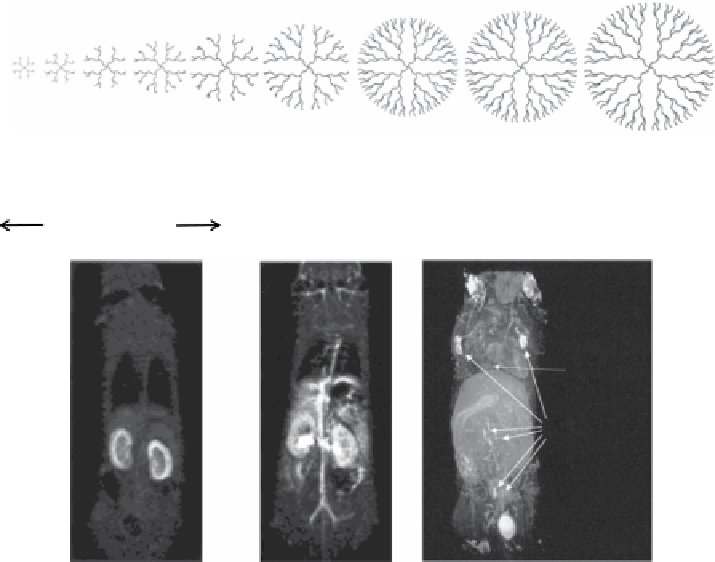Biomedical Engineering Reference
In-Depth Information
G1
(1.9 nm)
G2
(2.6 nm)
G3
(3.6 nm)
G4
(4.4 nm)
G5
(5.7 nm)
G6
(7.2 nm)
G7
(8.8 nm)
G8
(9.8 nm)
G9
(11.4 nm)
Blood pool
Lymphatic
system
Liver
Kidney/bladder
S 30
(a)
(b)
(c)
Thoracic duct
Normal lymph nodes
FIGuRe 8.5
Top: size-dependent passive biodistribution of a series of pAMAM-Gd-dTpA
dendrimers. Bottom: (a) G4 with visualization of the kidneys and (b) G6 with visualization of
vasculature, 14 min postinjection (Reprinted with permission from Ref. [89]. © Wiley-Liss,
Inc.) (c) Visualization of the lymphatic system with G8 dendrimer 45 min postinjection
(Reprinted with permission from Ref. [91]. © American Association for Cancer Research.)
the generation number increases. The smaller generation pAMAM-dTpA
dendrimers (G1-G4) exhibit rapid clearance from the body via elimination
through the kidneys, whereas G5 and G6 are retained longer, improving signifi-
cantly visualization of fine vasculature [89]. Higher generations exhibit less renal
uptake with an increased elimination via the liver. The G8 dendrimer was shown
to produce better enhancement over time in tumor vasculature than G6 [90].
Interestingly, the circulation times of G6 and G8 were both shown to be long
enough for visualization of deep lymph nodes and vessels [91, 92]. similar size-
related behaviors were also observed with ppI-dTpA dendrimers as shown in a
study by Langereis
et al
. [93].
several studies have reported the importance of the nature of the dendrimers on
their biodistribution. For instance, G4 ppI dendrimers with their higher hydropho-
bicity than pAMAM have been shown to accumulate significantly more in mice liver,
allowing visualization of micrometastatic tumors of 0.3 mm diameter [94]. The
nature of the core can also be critical in the development of a better blood pool agent
as demonstrated by a study by Kobayashi
et al
. showing that the replacement of the






Search WWH ::

Custom Search